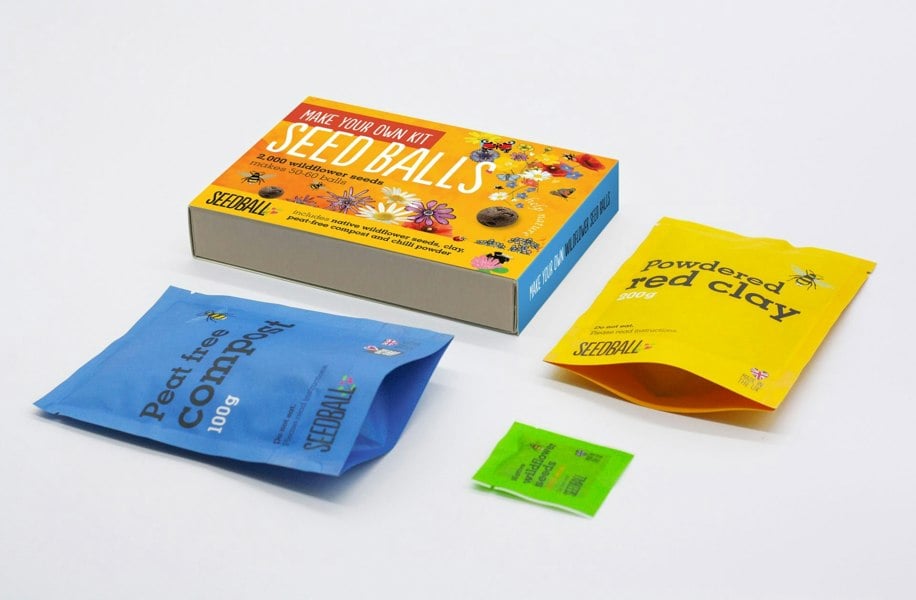

 0
0












SEEDBALL Make Your Own Bee & Butterfly Friendly Wildflower Seed Balls Kit
Visit the SEEDBALL store£15.00

Delivered Fast & Free by our E-concession Partner

Easy Returns - More info

UK Customer Support
Each pouch of seed contains a mix of bee and butterfly friendly wildflowers, including Poppy, Common toadflax, Cornflower, Cowslip, Meadow cranesbill, Musk mallow, Oxeye daisy and Red campion.
Once rolled, the seed balls are best scattered in the Autumn, followed by Spring (but as a rule of thumb anytime except winter is fine).
Common Poppy (Papaver rhoeas)
A bright red flowering annual - hugely popular and often used as a symbol of remembrance.
Height: 30-60cm.
Flowers: May to July
The remembrance poppy is the common field poppy, one of the first wildflowers to colonise disturbed ground or fallow cornfields. It became identified with the battle zones of the First World War, or Flanders Fields, which were originally corn fields.
Common Toadflax (Linaria vulgaris)
Perennial.
Height: 10-150cm
Flowers: June to October
There is an old belief that when you walk around the flower three times it will remove any spells that have been cast on you!
Cornflower (Centaurea cyanus)
Annual.
Height: 90cm
Flowers: June to August
Cornflowers are edible. They have a cucumber-like taste. Flowers can be consumed in the form of salad and tea, or used as a garnish.
Cowslip (Primula veris)
Perennial.
Height: 20-30cm
Scatter: Late summer or autumn
Flowers: April and May
The origin of the name cowslip is unclear, but it may derive from the fact that it grows in meadows well manured by cow dung or cow slips.
Meadow Cranesbill (Geranium pratense)
Perennial.
Height: 30-70cm
Flowers: June to September
The large purple flowers of Meadow cranesbill turn into pointed, bill-like seed pods that give the plant its common name.
Musk Mallow (Malva moschata)
Description: A tall perennial with large rose pink petals.
Height: 40-70cm
Flowers: June to August
The plant is cultivated for its seeds, which are used in perfumes. The plant also yields a fibre that can be used for clarifying sugar.
Oxeye Daisy (Leucanthemum vulgare)
Perennial.
Height: 30-90cm
Flowers: May to September
In Austria and Germany oxeye daisies were hung inside the house as it was believed they would repel lightning.
Red Campion (Silene dioica)
A perennial with rose pink petals.
Height: 20-60cm
Flowers: March to November
Silenus the merry god of the woodlands in Greek mythology, gave his name to Silene dioica. The second part of its scientific name, dioica, means 'two houses', and refers to the fact that each Red Campion plant has flowers of one sex only, so that two plants are needed to make seeds.
Yay! Make your own seed balls! It’s super fun, pretty messy and a brilliant activity for all ages!
Each kit includes 3 plastic free pouches of raw materials, which when mixed together with water will create enough mix for 40-60 balls (size depending!)
1. Bee & Butterfly Friendly Wildflower seeds (see mix details below)
2. Clay powder
3. Peat-free compost
You’ll need a mixing bowl, some water and a tray to dry the balls on. Also included is an instruction sheet giving full details of how to make the balls. Making seed balls can take from approximately 20 minutes to an hour depending on your dedication to rolling perfection!
These make for lovely gardening gifts, bee and butterfly gifts, eco friendly Christmas gifts or stocking fillers.




